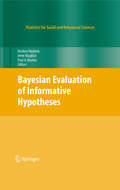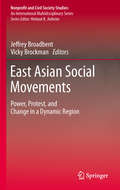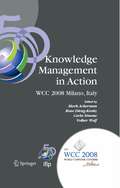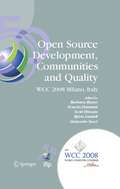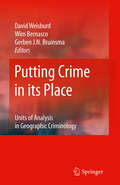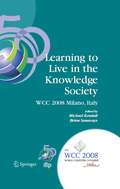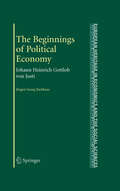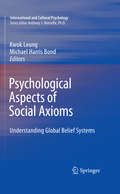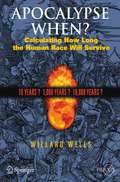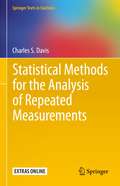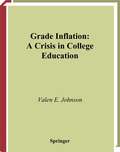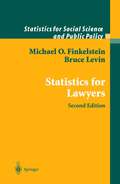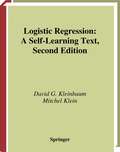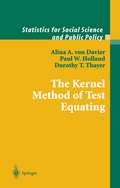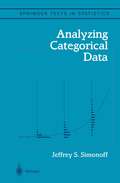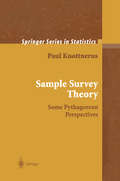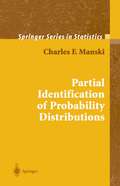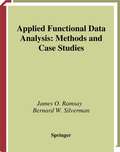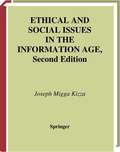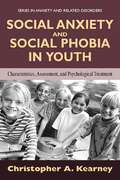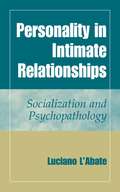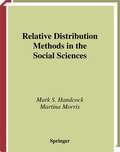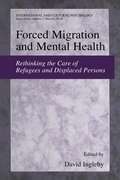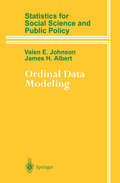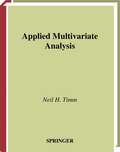- Table View
- List View
Bayesian Evaluation of Informative Hypotheses (Statistics for Social and Behavioral Sciences #Vol. 18)
by Paul Boelen Herbert Hoijtink Irene KlugkistThis book provides an overview of the developments in the area of Bayesian evaluation of informative hypotheses that took place since the publication of the ?rst paper on this topic in 2001 [Hoijtink, H. Con?rmatory latent class analysis, model selection using Bayes factors and (pseudo) likelihood ratio statistics. Multivariate Behavioral Research, 36, 563–588]. The current state of a?airs was presented and discussed by the authors of this book during a workshop in Utrecht in June 2007. Here we would like to thank all authors for their participation, ideas, and contributions. We would also like to thank Sophie van der Zee for her editorial e?orts during the construction of this book. Another word of thanks is due to John Kimmel of Springer for his con?dence in the editors and authors. Finally, we would like to thank the Netherlands Organization for Scienti?c Research (NWO) whose VICI grant (453-05-002) awarded to the ?rst author enabled the organization of the workshop, the writing of this book, and continuation of the research with respect to Bayesian evaluation of informative hypotheses.
East Asian Social Movements: Power, Protest, and Change in a Dynamic Region (Nonprofit and Civil Society Studies)
by Jeffrey Broadbent and Vicky BrockmanIn the study of civil society and social movements, most cases are based in Western Europe and North America. These two areas of the world have similar histories and political ideals and structures in common which in turn, affect the structure of its civil society. In studying civil society in Asia, a different understanding of history, politics, and society is needed. The region’s long traditions of centralized, authoritarian states buttressed by Confucian and in some cases Communist ideologies may render this concept irrelevant. The chapters in this international volume cover most of the areas and countries traditionally defined as belonging to East Asia: Japan, Taiwan, South Korea, Hong Kong, Singapore and China. The case studies included in this volume confront the utility of using the Western concept of civil society, represented in its most active form – social movements – to think about East Asia popular politics. Along with providing an array of important case studies of social movements in East Asia, the introduction, chapters and conclusion in the book take up three major theoretical questions: the effect of the East Asian cultural, social and institutional context upon the mobilization, activities and outcomes of social movements in that region, the role of social movements in larger transformative processes, utility of Western social movement concepts in explaining social movements in East Asia. This book will be of interest to two major groups of readers, those who study East Asia and those who pursue social movements and civil society, as well as politics more generally.
Knowledge Management in Action: IFIP 20th World Computer Congress, Conference on Knowledge Management in Action, September 7-10, 2008, Milano, Italy (IFIP Advances in Information and Communication Technology #270)
by Mark S. Ackerman Rose Dieng Carla Simone Volker WulfInternational Federation for Information Processing The IFIP series publishes state-of-the-art results in the sciences and technologies of information and communication. The scope of the series includes: foundations of computer science; software theory and practice; education; computer applications in technology; communication systems; systems modeling and optimization; information systems; computers and society; computer systems technology; security and protection in information processing systems; artificial intelligence; and human-computer interaction. Proceedings and post-proceedings of refereed international conferences in computer science and interdisciplinary fields are featured. These results often precede journal publication and represent the most current research. The principal aim of the IFIP series is to encourage education and the dissemination and exchange of information about all aspects of computing. For more information about the 300 other books in the IFIP series, please visit www.springer.com. For more information about IFIP, please visit www.ifip.org.
Open Source Development, Communities and Quality: IFIP 20th World Computer Congress, Working Group 2.3 on Open Source Software, September 7-10, 2008, Milano, Italy (IFIP Advances in Information and Communication Technology)
by Barbara Russo Ernesto Damiani Scott Hissam Bjö Lundell Giancarlo SucciWe are very pleased to introduce Open Source Development, Communities and Quality. The International Conference on Open Source Systems has come to its fourth edition – OSS 2008. Now, Free, Libre, and Open Source software is by all means now one of the most relevant subjects of study in several disciplines, ranging from information technology to social sciences and including also law, business, and political sciences. There are several conference tracks devoted to open source software with several publications appearing in high quality journals and magazines. OSS 2008 has been organized with the purpose of being the reference venue for those working in this area, being the most prominent conference in this area. For this th reason OSS 2008 has been located within the frameworks of the 20 World Computer Congress, WCC 2008, in Milan, the largest event of IFIP in 2008. We believe that this conference series, and the IFIP working group it represents, can play an important role in meeting these challenges, and hope that this book will become a valuable contribution to the open source body of research.
Putting Crime in its Place: Units of Analysis in Geographic Criminology (The\handbook Of Environmental Chemistry Ser. #Vol. 1, Part A)
by David Weisburd Wim Bernasco Gerben BruinsmaPutting Crime in its Place: Units of Analysis in Geographic Criminology focuses on the units of analysis used in geographic criminology. While crime and place studies have been a part of criminology from the early 19th century, growing interest in crime places over the last two decades demands critical reflection on the units of analysis that should form the focus of geographic analysis of crime. Should the focus be on very small units such as street addresses or street segments, or on larger aggregates such as census tracts or communities? Academic researchers, as well as practical crime analysts, are confronted routinely with the dilemma of deciding what the unit of analysis should be when reporting on trends in crime, when identifying crime hot spots or when mapping crime in cities. In place-based crime prevention, the choice of the level of aggregation plays a particularly critical role. This peer reviewed collection of essays aims to contribute to crime and place studies by making explicit the problems involved in choosing units of analysis in geographic criminology. Written by renowned experts in the field, the chapters in this book address basic academic questions, and also provide real-life examples and applications of how they are resolved in cutting-edge research. Crime analysts in police and law enforcement agencies as well as academic researchers studying the spatial distributions of crime and victimization will learn from the discussions and tools presented.
Learning to Live in the Knowledge Society: IFIP 20th World Computer Congress, IFIP TC 3 ED-L2L Conference, September 7-10, 2008, Milano, Italy (IFIP Advances in Information and Communication Technology #Vol. 173)
by Michael Kendall Brian SamwaysED-L2L, Learning to Live in the Knowledge Society, is one of the co-located conferences of the 20th World Computer Congress (WCC2008). The event is organized under the auspices of IFIP (International Federation for Information Processing) and is to be held in Milan from 7th to 10th September 2008. ED-L2L is devoted to themes related to ICT for education in the knowledge society. It provides an international forum for professionals from all continents to discuss research and practice in ICT and education. The event brings together educators, researchers, policy makers, curriculum designers, teacher educators, members of academia, teachers and content producers. ED-L2L is organised by the IFIP Technical Committee 3, Education, with the support of the Institute for Educational Technology, part of the National Research Council of Italy. The Institute is devoted to the study of educational innovation brought about through the use of ICT. Submissions to ED-L2L are published in this conference book. The published papers are devoted to the published conference themes: Developing digital literacy for the knowledge society: information problem solving, creating, capturing and transferring knowledge, commitment to lifelong learning Teaching and learning in the knowledge society, playful and fun learning at home and in the school New models, processes and systems for formal and informal learning environments and organisations Developing a collective intelligence, learning together and sharing knowledge ICT issues in education - ethics, equality, inclusion and parental role Educating ICT professionals for the global knowledge society Managing the transition to the knowledge society
The Beginnings of Political Economy: Johann Heinrich Gottlob von Justi (The European Heritage in Economics and the Social Sciences #7)
by Jügen Georg BackhausJu¨ rgen G. Backhaus 1 Johann Heinrich Gottlob (von) Justi was born in 1702 in Bru¨ cken in Prussia (county of Sangerhausen), studied law and cameral sciences in Wittenberg and Jena, yet had to leave the university, entered the Prussian military service, was captured during the Austrian war of succession by the Austrians but escaped to Leipzig (Saxony) where he studied mineral sciences. In 1750 he was called to a chair ‘‘Cameral Sciences and Rhetorics’’ at the new Theresian Academy of Knights in Vienna. There, he gave two important inaugural lectures which are the focal point of this book. In 1754, Justi was appointed a mineral counsellor in Gottingen ¨ (Hanover), and lectured at the Saxonian University on both state sciences and natural sciences. In 1762, Frederic II (the Great) of Prussia appointed him Prussian captain (highest supervisory position) of mines and general supervisor of fiscal-mineral activities. In 1768 he was accused of embezzlement, and before he could prove his innocence, he died in 1771 as a prisoner in the (decaying) fortress of Ku¨ strin. Due to his death, the case was never decided. But Frederic had obviously made his own decision. When he appointed Justi, the appointee pointed out that he was suffering from weak eye sight and could not readily check the bookkeeping. Frederic replied: You may have weak eyes but you have a bright mind. I shall put two eyes by your side.
Psychological Aspects of Social Axioms: Understanding Global Belief Systems (International and Cultural Psychology)
by Michael Harris Bond Kwok LeungHumans are surrounded by trillions of stimuli. Their eyes, for instance, can discriminate 7,500,000 colors. But, there is a severe limitation in the number of discriminably different stimuli that they can process at one time. George Miller argued that they can handle no more than seven, plus or minus two independent pieces of information at any given time. Thus, necessarily they must develop ways to simplify the task of processing the information that exists in their environment. They do this in many ways. One way is to select the stimuli that are most imp- tant in their lives, what are often called values. Another way is to chunk stimuli by linking them to each other, so they form bundles of stimuli that can be processed as if they are one entity. Generalized expectancies of what is linked with what are beliefs, and these beliefs are structured into bundles (see Triandis, 1972).
Apocalypse When?: Calculating How Long the Human Race Will Survive (Springer Praxis Books)
by Willard WellsThis book will be a key trailblazer in a new and upcoming field. The author’s predictive approach relies on simple and intuitive probability formulations that will appeal to readers with a modest knowledge of astronomy, mathematics, and statistics. Wells’ carefully erected theory stands on a sure footing and thus should serve as the basis of many rational predictions of survival in the face of not only natural disasters such as hits by asteroids or comets, but perhaps more surprisingly from man-made hazards arising from genetic engineering or robotics. Any formula for predicting human survival will invite controversy. Dr Wells counters anticipated criticism with a thorough approach in which four lines of reasoning are used to arrive at the same survival formula. One uses empirical survival statistics for business firms and stage shows. Another is based on uncertainty of risk rates. The third, more abstract, invokes Laplace’s principle of insufficient reason and involves an observer’s random arrival in the lifetime of the entity (the human race) in question. The fourth uses Bayesian theory. The author carefully explains and gives examples of the conditions under which his principle is valid and provides evidence that can counteract the arguments of critics who would reject it entirely. His deflection of possible criticisms results from two major premises: selecting the proper random variable and “reference class” to make predictions, and the recognition that if one does not know the law that governs a process, then the best prediction that can be made is his own formula.
Statistical Methods for the Analysis of Repeated Measurements (Springer Texts in Statistics)
by Charles S. DavisA comprehensive introduction to a wide variety of statistical methods for the analysis of repeated measurements. It is designed to be both a useful reference for practitioners and a textbook for a graduate-level course focused on methods for the analysis of repeated measurements. The important features of this book include a comprehensive coverage of classical and recent methods for continuous and categorical outcome variables; numerous homework problems at the end of each chapter; and the extensive use of real data sets in examples and homework problems.
Grade Inflation: A Crisis in College Education
by Valen E. JohnsonGrade inflation runs rampant at most colleges and universities, but faculty and administrators are seemingly unwilling to face the problem. This book explains why, exposing many of the misconceptions surrounding college grading. Based on historical research and the results of a yearlong, on-line course evaluation experiment conducted at Duke University during the 1998-1999 academic year, the effects of student grading on various educational processes, and their subsequent impact on student and faculty behavior, is examined. Principal conclusions of this investigation are that instructors' grading practices have a significant influence on end-of-course teaching evaluations, and that student expectations of grading practices play an important role in the courses that students decide to take. The latter effect has a serious impact on course enrollments in the natural sciences and mathematics, while the combination of both mean that faculty have an incentive to award high grades, and students have an incentive to choose courses with faculty who do. Grade inflation is the natural consequence of this incentive system. Material contained in this book is essential reading for anyone involved in efforts to reform our postsecondary educational system, or for those who simply wish to survive and prosper in it. Valen Johnson is a Professor of Biostatistics at the University of Michigan. Prior to accepting an appointment in Ann Arbor, he was a Professor of Statistics and Decision Sciences at Duke University, where data for this book was collected. He is a Fellow of the American Statistical Association.
Statistics for Lawyers (Statistics for Social and Behavioral Sciences)
by Michael O. Finkelstein Bruce LevinDesigned to introduce law students, law teachers, practitioners, and judges to the basic ideas of mathematical probability and statistics as they have been applied in the law, the book consists of sections of exposition followed by real-world cases and case studies in which stastical data have played a role. Readers are asked to apply the theory to the facts, to calculate results (a pocket calculator is sufficient), and to explore legal issues raised by quantitative findings, while the author's own calculations and comments are given in the back of the book. The cases and case studies reflect a broad variety of legal subjects, including antidiscrimination, mass torts, taxation, school finance, identification evidence, preventive detention, handwriting disputes, voting, environmental protection, antitrust, and the death penalty. The first edition has been used in law, statistics, and social science courses, and in 1991 was selected by the University of Michigan Law Review as one of the important law books of the year. This second edition includes many new problems reflecting current developments in the law, including a new chapter on epidemiology.
Logistic Regression: A Self-Learning Text (Statistics for Biology and Health)
by David G. Kleinbaum Mitchel KleinThis is the second edition of this text on logistic regression methods, ori- nally published in 1994. As in the first edition, each chapter contains a presentation of its topic in “lecture-book” format together with objectives, an outline, key formulae, practice exercises, and a test. The “lecture-book” has a sequence of illust- tions and formulae in the left column of each page and a script (i.e., text) in the right column. This format allows you to read the script in conjunction with the illustrations and formulae that highlight the main points, formulae, or examples being presented. This second edition has expanded the first edition by adding five new ch- ters and a new appendix. The five new chapters are Chapter 9. Polytomous Logistic Regression Chapter 10. Ordinal Logistic Regression Chapter 11. Logistic Regression for Correlated Data: GEE Chapter 12. GEE Examples Chapter 13. Other Approaches for Analysis of Correlated Data Chapters 9 and 10 extend logistic regression to response variables that have more than two categories. Chapters 11–13 extend logistic regression to gen- alized estimating equations (GEE) and other methods for analyzing cor- lated response data. The appendix is titled “Computer Programs for Logistic Regression” and p- vides descriptions and examples of computer programs for carrying out the variety of logistic regression procedures described in the main text. The so- ware packages considered are SAS Version 8.0, SPSS Version 10.0, and STATA Version 7.0.
The Kernel Method of Test Equating (Statistics for Social and Behavioral Sciences)
by Alina A. Davier Paul W. Holland Dorothy T. ThayerKE is applied to the four major equating designs and to both Chain Equating and Post-Stratification Equating for the Non-Equivalent groups with Anchor Test Design. It will be an important reference for several groups: (a) Statisticians (b) Practitioners and (c) Instructors in psychometric and measurement programs. The authors assume some familiarity with linear and equipercentile test equating, and with matrix algebra.
Analyzing Categorical Data (Springer Texts in Statistics)
by Jeffrey S. SimonoffCategorical data arise often in many fields, including biometrics, economics, management, manufacturing, marketing, psychology, and sociology. This book provides an introduction to the analysis of such data. The coverage is broad, using the loglinear Poisson regression model and logistic binomial regression models as the primary engines for methodology. Topics covered include count regression models, such as Poisson, negative binomial, zero-inflated, and zero-truncated models; loglinear models for two-dimensional and multidimensional contingency tables, including for square tables and tables with ordered categories; and regression models for two-category (binary) and multiple-category target variables, such as logistic and proportional odds models. All methods are illustrated with analyses of real data examples, many from recent subject area journal articles. These analyses are highlighted in the text, and are more detailed than is typical, providing discussion of the context and background of the problem, model checking, and scientific implications. More than 200 exercises are provided, many also based on recent subject area literature. Data sets and computer code are available at a web site devoted to the text. Adopters of this book may request a solutions manual from: textbook@springer-ny.com. From the reviews: "Jeff Simonoff's book is at the top of the heap of categorical data analysis textbooks...The examples are superb. Student reactions in a class I taught from this text were uniformly positive, particularly because of the examples and exercises. Additional materials related to the book, particularly code for S-Plus, SAS, and R, useful for analysis of examples, can be found at the author's Web site at New York University. I liked this book for this reason, and recommend it to you for pedagogical purposes." (Stanley Wasserman, The American Statistician, August 2006, Vol. 60, No. 3) "The book has various noteworthy features. The examples used are from a variety of topics, including medicine, economics, sports, mining, weather, as well as social aspects like needle-exchange programs. The examples motivate the theory and also illustrate nuances of data analytical procedures. The book also incorporates several newer methods for analyzing categorical data, including zero-inflated Poisson models, robust analysis of binomial and poisson models, sandwich estimators, multinomial smoothing, ordinal agreement tables…this is definitely a good reference book for any researcher working with categorical data." Technometrics, May 2004 "This guide provides a practical approach to the appropriate analysis of categorical data and would be a suitable purchase for individuals with varying levels of statistical understanding." Paediatric and Perinatal Epidemiology, 2004, 18 "This book gives a fresh approach to the topic of categorical data analysis. The presentation of the statistical methods exploits the connection to regression modeling with a focus on practical features rather than formal theory...There is much to learn from this book. Aside from the ordinary materials such as association diagrams, Mantel-Haenszel estimators, or overdispersion, the reader will also find some less-often presented but interesting and stimulating topics...[T]his is an excellent book, giving an up-to-date introduction to the wide field of analyzing categorical data." Biometrics, September 2004 "...It is of great help to data analysts, practitioners and researchers who deal with categorical data and need to get a necessary insight into the methods of analysis as well as practical guidelines for solving problems." International Journal of General Systems, August 2004 "The author has succeeded in writing a useful and readable textbook combining most of general theory and practice of count data." Kwantitatieve Methoden "The book especially stresses how to analyze and interpret data...In fact, the highly detailed mult
Sample Survey Theory: Some Pythagorean Perspectives (Springer Series in Statistics)
by Paul KnottnerusThis book describes a novel approach to the theory of sampling from finite populations. The new unifying approach is based on the sampling autocorrelation coefficient. The author derives a general set of sampling equations that describe the estimators, their variances as well as the corresponding variance estimators. This volume will be useful for survey practitioners faced with complex surveys.
Partial Identification of Probability Distributions (Springer Series in Statistics)
by Charles F. ManskiThe book presents in a rigorous and thorough manner the main elements of Charles Manski's research on partial identification of probability distributions. The approach to inference that runs throughout the book is deliberately conservative and thoroughly nonparametric. There is an enormous scope for fruitful inference using data and assumptions that partially identify population parameters.
Applied Functional Data Analysis: Methods and Case Studies (Springer Series in Statistics)
by J.O. Ramsay B.W. SilvermanThis book contains the ideas of functional data analysis by a number of case studies. The case studies are accessible to research workers in a wide range of disciplines. Every reader should gain not only a specific understanding of the methods of functional data analysis, but more importantly a general insight into the underlying patterns of thought. There is an associated web site with MATLABr and S?PLUSr implementations of the methods discussed.
Ethical and Social Issues in the Information Age (Texts in Computer Science)
by Joseph M. KizzaThis textbook provides an introduction to the social and policy issues which have arisen as a result of information technology. Whilst it assumes a modest familiarity with computers, its aim is to provide a guide to the issues suitable for undergraduates. In doing so, the author prompts the students to consider questions such as: "What are the moral codes of cyberspace?" Throughout, the book shows how in many ways the technological development is outpacing the ability of our legal systems to keep up, and how different paradigms applied to ethical questions may often offer conflicting conclusions. As a result students will find this to be a thought-provoking and valuable survey.
Social Anxiety and Social Phobia in Youth: Characteristics, Assessment, and Psychological Treatment (Series in Anxiety and Related Disorders)
by Christopher KearneyA great bene?t of being a clinical child psychologist is the opportunity to conduct and review research on fascinating areas of human, youthful behavior. And perhaps no behavior is as central to human existence as social behavior, and the lack thereof. In writing this book, therefore, I have been doubly blessed with the chance to examine seminal works on behaviors that are so critical to the development and quality of life of children. This book covers the major historical aspects, characteristics, asse- ment strategies, and psychological treatment techniques for youths with social anxiety and social phobia. Chapter 1 provides an introduction to the related constructs and history of social phobia. Chapters 2 and 3 provide a summary of the characteristics and etiological variables that pertain most to youths with social anxiety and social phobia. Chapters 4 and 5 provide an overview of research- and clinically-based assessment strategies and recommendations for this population. Chapters 6–9 provide a description of treatment techniques that are most relevant and empirically supported for youths with social anxiety and social phobia. Chapter 10 covers issues regarding general and relapse prevention as well as dif?cult cases and future directions.
Personality in Intimate Relationships: Socialization and Psychopathology
by Luciano L'AbateFour decades of contributions to personality theory and family practice have earned Luciano L’Abate a worldwide reputation for therapeutic insights. Now he expands on his pathbreaking relational theory of personality to apply it to the twenty-first-century family in all its configurations. Personality in Intimate Relationships showcases L’Abate’s trademark elegant style and provocative ideas in his most accessible work to date.Based on Axes I and II of the DSM-IV, the book describes relationships along a readily identifiable continuum ranging from optimal functionality to severe pathology, linking the author’s conceptual framework to specific diagnostic strategies, therapeutic interventions, and prevention programs. L’Abate’s theory not only integrates individual and family theories and seemingly disparate schools of thought, but is also inclusive of nontraditional relationships—grandparent/grandchild dyads, adoptive families, same-sex couples, and others—that are often left out of the family literature.Among the key areas explored in the book:• Selfhood and self-differentiation• Confrontation and sharing of hurt feelings• Negotiating, bargaining, and problem-solving• Dealing with distance and closeness• Intimacy and the ability to love In addition, the reader is referred to complementary online appendices that supply helpful questionnaires, workbooks, and ideas for further applications.Personality in Intimate Relationships offers fresh perspective to all frontline practitioners as well as investigators in this area. It is also ideal for graduate courses in abnormal psychology and personal development.
Relative Distribution Methods in the Social Sciences (Statistics for Social and Behavioral Sciences)
by Mark S. Handcock Martina MorrisThis monograph presents methods for full comparative distributional analysis based on the relative distribution. This provides a general integrated framework for analysis, a graphical component that simplifies exploratory data analysis and display, a statistically valid basis for the development of hypothesis-driven summary measures, and the potential for decomposition - enabling the examination of complex hypotheses regarding the origins of distributional changes within and between groups. Written for data analysts and those interested in measurement, the text can also serve as a textbook for a course on distributional methods.
Forced Migration and Mental Health: Rethinking the Care of Refugees and Displaced Persons (International and Cultural Psychology)
by David InglebyAlthough forced migration is not new in human history it has become, in our time, one of the world's major problems. In the last few decades, armed conflict and political unrest have created vast numbers of asylum seekers, refugees and displaced persons. This has led, in turn to increasing involvement of professional care workers and agencies, both governmental and nongovernmental. While there is no doubt on the part of helping parties that care is necessary, there is considerable debate about the kind of care that is needed. This book presents a critical review of mental health care provisions for people who have had to leave their homeland, and explores the controversies surrounding this topic. Providing fresh perspectives on an age old problem, this book covers humanitarian aid and reconstruction programs as well as service provision in host countries. It is of interest to all those who provide health services, create policy, and initiate legislation for these populations.
Ordinal Data Modeling (Statistics for Social and Behavioral Sciences)
by Valen E. Johnson James H. AlbertOrdinal Data Modeling is a comprehensive treatment of ordinal data models from both likelihood and Bayesian perspectives. A unique feature of this text is its emphasis on applications. All models developed in the book are motivated by real datasets, and considerable attention is devoted to the description of diagnostic plots and residual analyses. Software and datasets used for all analyses described in the text are available on websites listed in the preface.
Applied Multivariate Analysis (Springer Texts in Statistics)
by Neil H. TimmThis book provides a broad overview of the basic theory and methods of applied multivariate analysis. The presentation integrates both theory and practice including both the analysis of formal linear multivariate models and exploratory data analysis techniques. Each chapter contains the development of basic theoretical results with numerous applications illustrated using examples from the social and behavioral sciences, and other disciplines. All examples are analyzed using SAS for Windows Version 8.0.
